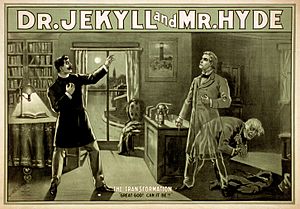Dissociative identity disorder facts for kids
Dissociative identity disorder (DID) is a type of mental disorder. It used to be called multiple personality disorder (MPD). Doctors list it in a special guidebook called the DSM IV, which helps them understand and diagnose different mental health conditions.
DID is a topic that doctors and scientists sometimes disagree about, especially when it comes to what causes it. The main signs of DID are when a person shows two or more different "identities" or "personality states." This means their behavior, memories, and thoughts can change depending on which identity is in control. Another important sign is when a person forgets important personal things that most people would easily remember.
Doctors do not diagnose DID if the symptoms are caused by certain medicines, other illnesses, or, in children, if they are just pretending to play with imaginary friends. Doctors also make sure that a person isn't just pretending to have DID for attention, sympathy, or to get something they want. Many people who have DID also have other mental health conditions.
Contents
Understanding Dissociative Identity Disorder
Dissociative identity disorder, or DID, is a complex mental health condition. It affects how a person thinks, feels, and acts. People with DID often feel like different parts of themselves are separate.
What is DID?
DID involves a person having two or more distinct identities or personality states. Each identity might have its own way of thinking, feeling, and behaving. These different identities can take control of the person's actions at different times.
Key Signs of DID
One of the main signs is having these different identities. Another key sign is significant memory loss. This isn't just forgetting where you put your keys. It's forgetting important personal information, like parts of your past or things you've done.
How Doctors Understand DID
Doctors use a special manual called the DSM IV to help them diagnose mental health conditions. DID is listed in this manual, which means it's a recognized condition. However, there are still many discussions among experts about how DID develops.
Important Things Doctors Look For
When a doctor thinks someone might have DID, they look for specific signs. They check if the person truly has different identities that take control. They also look for memory gaps that are too big to be normal forgetfulness.
What Causes DID?
Many experts believe that DID often develops in people who have experienced very difficult or traumatic events, especially during childhood. These events might include severe neglect or abuse. The mind might create different identities as a way to cope with overwhelming stress or pain.
Why Some People Get DID
It's thought that creating separate identities helps a person distance themselves from painful memories or experiences. It's like a way for the mind to protect itself from something too hard to handle. This is why it's called a "dissociative" disorder, meaning parts of the mind become separated.
How is DID Diagnosed?
Diagnosing DID is a careful process. Doctors need to rule out other possible reasons for the symptoms. They make sure the symptoms are not caused by other medical conditions or by using certain substances.
Ruling Out Other Reasons
Doctors also check to make sure the person isn't just pretending to have DID. Sometimes, people might pretend to have symptoms for attention or other reasons. This is why a thorough evaluation by a mental health professional is very important.
Other Conditions Often Seen with DID
It's common for people with DID to also have other mental health conditions. These might include depression, anxiety disorders, or post-traumatic stress disorder (PTSD). Treating all these conditions together is often part of the recovery process.
See also
 In Spanish: Trastorno de identidad disociativo para niños
In Spanish: Trastorno de identidad disociativo para niños


